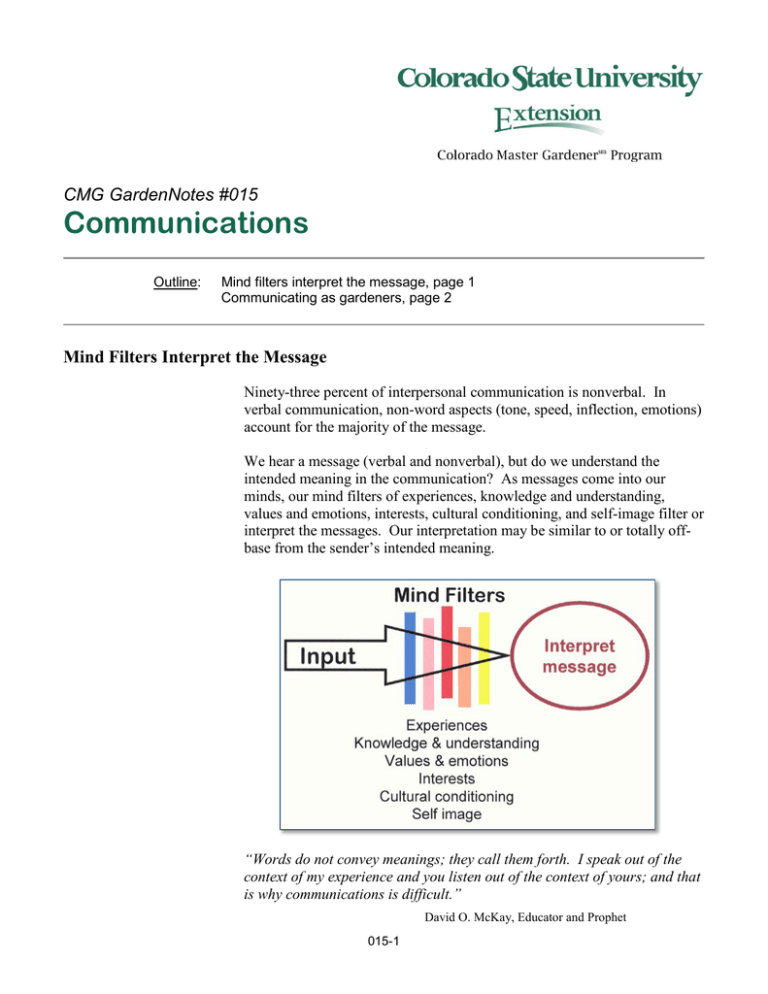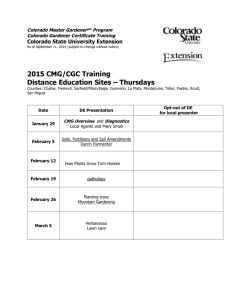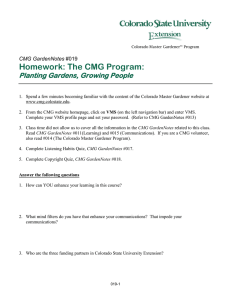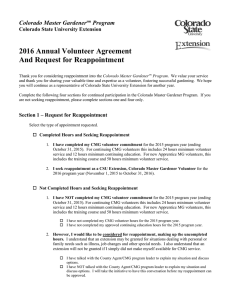Communications CMG GardenNotes #015 Mind Filters Interpret the Message
advertisement

CMG GardenNotes #015 Communications Outline: Mind filters interpret the message, page 1 Communicating as gardeners, page 2 Mind Filters Interpret the Message Ninety-three percent of interpersonal communication is nonverbal. In verbal communication, non-word aspects (tone, speed, inflection, emotions) account for the majority of the message. We hear a message (verbal and nonverbal), but do we understand the intended meaning in the communication? As messages come into our minds, our mind filters of experiences, knowledge and understanding, values and emotions, interests, cultural conditioning, and self-image filter or interpret the messages. Our interpretation may be similar to or totally offbase from the sender’s intended meaning. “Words do not convey meanings; they call them forth. I speak out of the context of my experience and you listen out of the context of yours; and that is why communications is difficult.” David O. McKay, Educator and Prophet 015-1 Communication becomes more difficult when it involves messages linked to strong emotions or values. Common examples include discussions on money, religion, politics, love, sex, drugs, and violence. Recognizing when emotions and values (from either party) play into the message helps defuse sensitive issues. Repeating back, in your own words, what you hear is an effective tool in helping to clarify meaning. Communicating as Gardeners In the gardening arena, communication barriers may include emotions and values related to pesticides, organic gardening, xeriscaping, expectations of what a garden should look like, and expectations about the time someone invests in gardening activities. In diagnosing plant disorders, communication is key. The client will describe the situation based on his/her observations and gardening experiences. The CMG volunteer will interpret based on his/her gardening experiences. Inevitably, there will be some miscommunication! In CMG volunteer work, we are often called upon to diagnose plant disorders solely through verbal descriptions by the client. As most clients don’t know what to look for in the diagnostic process, the description will typically be lacking in detail. Diagnosis may be impossible. As professionals, we need to recognize that we have very limited potential to diagnose plant disorders over the phone or in a clinical setting. It is natural to add details about the plant’s problem based on our experiences, but details added by our mind filters may be totally off base for the specific situation. In talking with clients about gardening problems, ask lots of questions and do lots of listening. Ask questions to verify every detail raised by your mind filters. Repeating back in your own words what you are hearing often helps to clarify where mind filters are interfering with communication. Author: David Whiting, Extension Consumer Horticulture Specialist and State CMG Coordinator (retired), Dept. of Horticulture & LA, Colorado State University. Artwork by David Whiting; used by permission. o o o o o o Colorado Master Gardener GardenNotes are available online at www.cmg.colostate.edu. Colorado Master Gardener training is made possible, in part, by a grant from the Colorado Garden Show, Inc. Colorado State University, U.S. Department of Agriculture and Colorado counties cooperating. Extension programs are available to all without discrimination. No endorsement of products mentioned is intended nor is criticism implied of products not mentioned. Copyright 2003-2014. Colorado State University Extension. All Rights Reserved. CMG GardenNotes may be reproduced, without change or additions, for nonprofit educational use. Revised October 2014 015-2



